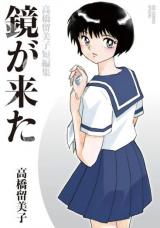This collection contains five horror-adjacent one-shots published in the span of around 16 years, plus a semi-autobiographical short co-written with Mitsuru Adachi. None of the stories are connected in any meaningful way, except for the fact that they tell somewhat prosaic stories in which something strange or unexpected happens in the lives of the main characters. For example, in the titular "Came the Mirror", middle-schoolers grow mirrors on their palms with which they can see evil and exorcise people, while in "With Cat" a boy who hates cats is cursed to become one.
Not all of the stories are supernatural, though, with "The Star," about a young TV actress running away because of murder, and "Lovely Flower," about a stalker, more in the realm of the thriller. The former one, however, is possibly the worst in the entire collection due to its awkward pacing and, at times, weak narration. The story also borrows a lot from American and British thrillers, but shows lack of in-depth knowledge about their conventions.
The remaining two stories, the supernatural revenge drama "Revenge Doll" and the autobiographical "My Sweet Sunday" are about manga, and are arguably the best stories in the collection. The first was written to celebrate the 45th anniversary of Big Comic, while the second - the 50th anniversary of Weekly Shonen Sunday. "Revenge Doll" tells the story of an inert one hit wonder manga artist whose career is on the brink of being over who receives a mysterious doll that grants wishes. He uses is not for revenge, though, but to punish everyone who he believes has done him wrong - his talented assistants, his harsh editor, his lover. In the end, as it always happens in these stories, he is the one that gets the swift punishment. Where this short excels, however, is not the story itself, but the design of the doll, which is somewhat reminiscent of something that Daijiro Morohoshi could've drawn. Also, as a manga about manga, some of the panels contain pages of thethe incredibly generic manga drawn by the main character, making us appreciate even more Takahashi's unique style.
Despite all this, "Came the Mirror" leaves a lot to be desired. Some of the art might be beautiful and the character design, nostalgic-yet-refreshing, but the stories themselves feel incomplete. None of them is given enough space to develop naturally, nor to draw is into its world. The blame for that might fall somewhat on the constrains given by the publishers, but not entirely, as Rumiko Takahashi seems to just be much better at creating long, complex narratives, than short ones.





